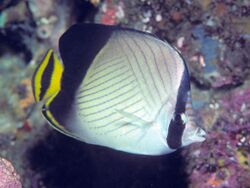Biology:Indian vagabond butterflyfish
| Indian vagabond butterflyfish | |
|---|---|

| |
| Scientific classification | |
| Domain: | Eukaryota |
| Kingdom: | Animalia |
| Phylum: | Chordata |
| Class: | Actinopterygii |
| Order: | Perciformes |
| Family: | Chaetodontidae |
| Genus: | Chaetodon |
| Subgenus: | Chaetodon (Rabdophorus) |
| Species: | C. decussatus
|
| Binomial name | |
| Chaetodon decussatus G. Cuvier, 1829
| |
| Synonyms[2] | |
| |
The Indian vagabond butterflyfish (Chaetodon decussatus), also known as the blackened butterflyfish or black-finned vagabond, is a species of marine ray-finned fish, a butterflyfish belonging to the family Chaetodontidae. It is found in the Indo-West Pacific, from the Maldives via India, Sri Lanka and the Andaman Sea to the westernmost portion of the Indonesian archipelago.[2]
The Indian vagabond butterflyfish has a silvery-white body marked with diagonal grey lines and with a broad black vertical band running through the eyes. The posterior lower part of the body is largely black. There are yellow markings on the tail and anal fins.[3] Growing to a maximum of 20 cm (nearly 8 in) long, it is found on rich coral reefs and also on rubble and rocky areas. The monogamous adults swim in pairs and may be territorial and aggressive to other Chaetodon; juveniles are solitary. The Indian vagabond butterflyfish feeds largely on algae and coral polyps. They are oviparous.[2]
The Indian vagabond butterflyfish was first formally described in 1829 by the French anatomist Georges Cuvier (1769-1832), the type locality was given as “India”.[4] It belongs to the large subgenus Rabdophorus which might warrant recognition as a distinct genus. In this group, it almost certainly is a rather close relative of the threadfin butterflyfish (C. auriga) and the vagabond butterflyfish (C. vagabundus). C. decussatus might be closer to the threadfin butterflyfish than to the common Vagabond Butterflyfish; as C. vagabundus has yielded abnormal DNA sequence data this is hard to say however. The C. auriga species group shares the characteristic pattern of two areas of ascending and descending oblique lines; species differ conspicuously in hindpart coloration.[5][6]
References
- ↑ Myers, R.F.; Pratchett, M. (2010). "Chaetodon decussatus". IUCN Red List of Threatened Species 2010: e.T165648A6080038. doi:10.2305/IUCN.UK.2010-4.RLTS.T165648A6080038.en. https://www.iucnredlist.org/species/165648/6080038. Retrieved 19 November 2021.
- ↑ 2.0 2.1 2.2 Froese, Rainer and Pauly, Daniel, eds. (2019). "Chaetodon decussatus" in FishBase. December 2019 version.
- ↑ "Chaetodon decussatus". Saltcorner. Bob Goemans. 2012. http://www.saltcorner.com/AquariumLibrary/browsespecies.php?CritterID=481&filter=0.
- ↑ Eschmeyer, William N.; Fricke, Ron; van der Laan, Richard, eds. "Species in the genus Chaetodon". California Academy of Sciences. http://researcharchive.calacademy.org/research/ichthyology/catalog/fishcatget.asp?tbl=species&genus=Chaetodon.
- ↑ Fessler, Jennifer L.; Westneat, Mark W (2007). "Molecular phylogenetics of the butterflyfishes (Chaetodontidae): Taxonomy and biogeography of a global coral reef fish family". Molecular Phylogenetics and Evolution 45 (1): 50–68. doi:10.1016/j.ympev.2007.05.018.
- ↑ Hsu, Kui-Ching; Chen, Jeng-Ping; Shao, Kwang-Tsao (2007). "Molecular phylogeny of Chaetodon (Teleostei: Chaetodontidae) in the Indo-West Pacific: evolution in geminate species pairs and species groups". Raffles Bulletin of Zoology Supplement 14: 77–86. http://rmbr.nus.edu.sg/rbz/biblio/s14/s14rbz10_Hsu-pp77-86.pdf. Retrieved 2008-09-02.
External links
- Photos of Indian vagabond butterflyfish on Sealife Collection
Wikidata ☰ Q2717397 entry
 |



